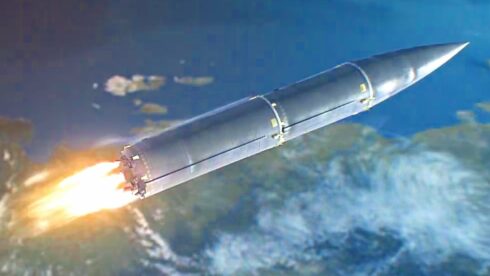Half Of Russian Strategic Missile Divisions Now Use Hypersonics In Res…
Written by Drago Bosnic, independent geopolitical and military analyst
It’s certainly not breaking news that Russia is the world’s leader in advanced military technologies, particularly new types of missiles and other similar weapons. As Moscow has a comfortable lead over Washington DC in both the development and deployment of hypersonic weapons, it has decided to capitalize on this massive advantage and is now using a greater portion of its second-to-none arsenal to deter the belligerent thalassocracy. Back in late June, Russian President Vladimir Putin stated that approximately half of all Russian strategic missile divisions have been rearmed with hypersonic warheads.
“About half of the units of Russia’s Strategic Missile Force [RVSN] have been equipped with the latest ‘Yars’ missile systems and are being rearmed with modern ‘Avangard’ warheads,” Putin was quoted by TASS, further adding: “In light of the new challenges and invaluable experience of the special military operation [SMO] we will continue to improve the Armed Forces in every possible way.”
Putin also stressed the importance of Russia’s efforts to further develop its nuclear triad as the key guarantee of the Eurasian giant’s strategic security, as well as geopolitical stability on a global level. In addition, he also announced that new units of the liquid fuel, super-heavy “Sarmat” ICBM (intercontinental ballistic missile) would “soon enter duty”. It would seem that this process is in its late phases and that Moscow will indeed deploy additional launchers of these unparalleled weapons. Russian president added that similar modernization efforts are being implemented in the other two legs of its nuclear triad.
At the time when the aforementioned statements were given, it wasn’t precisely clear why Putin “suddenly” had to emphasize the importance of Russia’s hypersonic weapons and other key strategic systems. Namely, in early July, the US Army reported that it has demonstrated the operational capability of its newest ground-based missile launcher with the system’s recent successful firing of a “Tomahawk” land-attack cruise missile. This came after a test launch of a multi-purpose SM-6 missile earlier this year from what is officially known as the “Typhon” Weapon System.
The US Army now has one unit registered under the official name Mid-Range Capability battery equipped with the “Typhon”, which has four trailer-based launchers and other supporting vehicles and equipment. The service’s Rapid Capabilities and Critical Technologies Office (RCCTO) announced the “Tomahawk” launch on June 28, but the actual test had occurred on the 27th. This came just over half a year ago after the US Army took delivery of its first “Typhon” launchers and other components of its first Mid-Range Capability (MRC) battery from Lockheed Martin, one of the giants of America’s Military Industrial Complex (MIC).
US Army’s top-ranking officials recently stated that their goal is to reach at least the initial level of true operational capability with the first MRC battery before the end of Fiscal Year 2023 (which will be in September this year). As previously mentioned, a complete “Typhon” battery consists of four launchers and a command post, all on trailers, as well as other support vehicles. The service plans to employ the “Typhon” primarily against ground targets using either “Tomahawk” or SM-6. And while the former has a land-based origin (Cold War-era BGM-109G “Gryphon”), the latter is a naval missile.
In fact, the SM-6 was originally designed as a surface-to-air missile (SAM), with a secondary anti-ship capability. However, the US Navy modified it and now operates several versions designed for multipurpose missions. Considering how far behind Russia the US is in terms of hypersonic weapons, the SM-6 is its best bet for engaging incoming highly-maneuverable hypersonic weapons. And even this is highly questionable, despite US attempts to present its ludicrous claims about the “Patriot” shooting down Russian hypersonic missiles as true. If that claim was true, the US would never need the SM-6 to counter Russian missiles.
The 9-A-7660 “Kinzhal’s” speed ranges from over 12,000 km per hour to almost 16,000 km per hour. If we were to imagine an interceptor missile flying at 4000 km per hour hitting another missile flying three or four times faster than that, can anyone really believe there would be anything more than a bunch of sparks, let alone a wreckage of any kind? Worse yet, the alleged “Russian ‘Kinzhal’ hypersonic missile” fell to the ground in a relatively good condition and was then even photographed and presented as supposed “evidence”. So, again, if nothing more than basic physics is taken into account, the claims become extremely difficult to even consider, let alone take at face value.
However, as the US has no operational hypersonic weapons of its own, with the most recent cancelation of its AGM-183A missile project, this capability for the Pentagon has been pushed further back. This is making it desperate to present Russia’s missiles as much worse than they truly are. And yet, In stark contrast to the US, Russia fields the Mach 12-capable “Kinzhal” air-launched hypersonic missile carried by modified MiG-31K/I interceptors and Tu-22M3 long-range bombers, the Mach 28-capable “Avangard” HGV deployed on various ICBMs and the Mach 9-capable scramjet-powered “Zircon” hypersonic cruise missile deployed on naval (both submarines and surface ships) and (soon) on land platforms.
Russia is decades ahead of the US, both in terms of deployment and hypersonic weapon capabilities. In addition, Moscow has been using these systems against the Kiev regime and NATO high-value targets in Ukraine. The Russian military is not just the world’s only armed force widely deploying hypersonic missiles, but it’s also the only one that has inducted them in all domains (air, land, sea), including on strategic weapons.
MORE ON THE TOPIC:
- Iranian Fattah Hypersonic Missile (Infographics)
- Kinzhal Hypersonic Missile Proved To Be Unstoppable In Ukraine: Russian Military Chief
- ‘Super-Duper’ Missile In Death Throes, Shattering US Hypersonic Ambitions
The post Half Of Russian Strategic Missile Divisions Now Use Hypersonics In Response To US Escalation appeared first on South Front.




























































